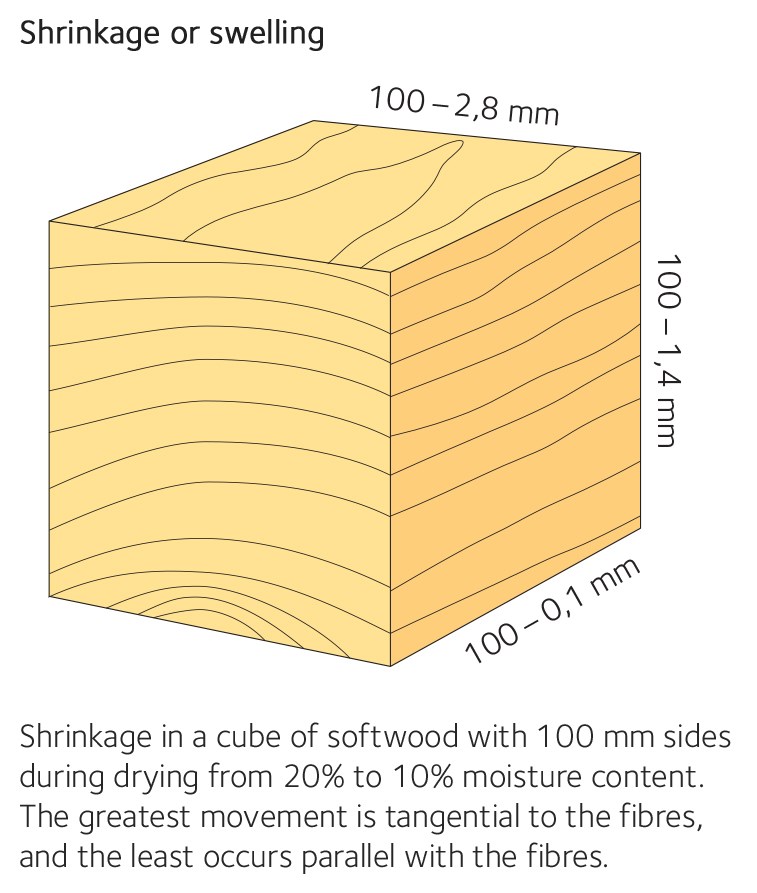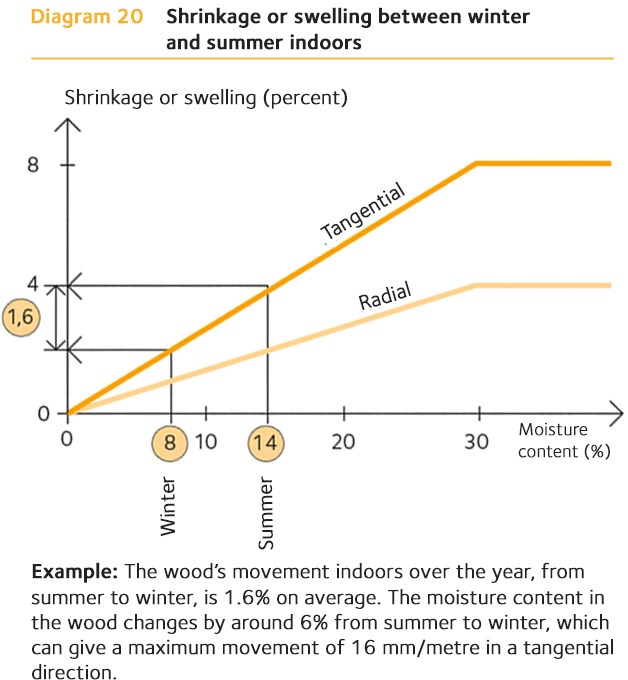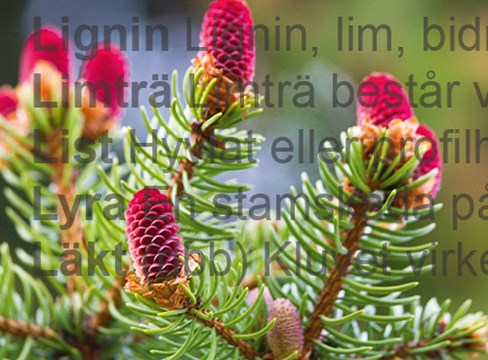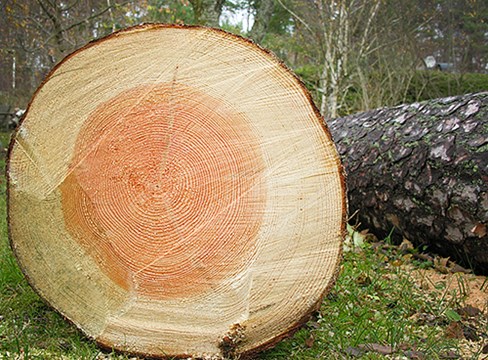Moisture-related wood movement
For floorboards, internal cladding and floor joists, the target moisture content should be 8, 12 and 16 percent respectively to minimise swelling or shrinkage, see diagram 15 under Moisture content, and the relevant product standard.
The moisture content of undried softwood is up to 160 percent in the sapwood and up to 50 percent in the heartwood. During drying, the first water to disperse is the unbound water in the gaps in the fibres’ cells. When the moisture content then reaches fibre saturation, at around 30 percent moisture content, the moisture in the cell walls begins to leave the wood, and this contributes to the wood beginning to shrink. The wood first begins to shrink in its outer parts, before later shrinking further in. This creates seasoning checks (cracks) if the drying temperature is too low or the drying happens too quickly. The shrinkage in the outer parts of the wood also causes high drying stresses, which can be reduced by introducing a conditioning phase after the drying. See the section Sawmill conditioned wood.
In a board or plank the growth rings are usually curved, which is why there is rarely purely tangential or radial shrinkage. A rule of thumb is therefore that the average movement (shrinkage or swelling) for pine and spruce in both a radial and tangential direction is around 0.26 percent per percentage point of change in the moisture content. See table 21 for the percentage of shrinkage per 1 percentage point moisture content change for other woods.
Example: A 95 mm wide floorboard with a moisture content of 17 percent is laid in a room with a climate equating to the wood’s equilibrium moisture content of 10 percent. The change in moisture content 17 – 10 = 7 percentage points. The board shrinks 7 x 0.0026 x 95 mm = approx. 1.8 mm in width.
The shrinkage will be half that size if the board is sawn in a radial direction rather than in a tangential direction, i.e. with vertical growth rings. The floorboard gaps will be half the size.
The wood’s movement is relatively slow, particularly in larger dimensions. It takes more than a year, for example, for the inner part of a thick timber wall to adapt to the surrounding climate.
The delivery moisture content for the wood from the sawmill was previously around 20 percent for planks and around 16 percent for boards on average. This was called “shipping dry”. Now the wood’s moisture content is adapted more to the product or application, for example in line with the requirements in the product standards and in AMA Hus. Since wood strives to achieve equilibrium with the air’s temperature and relative humidity, the moisture content will move towards the equilibrium moisture content. This takes quite a long time. Encased wood and joinery should have a moisture content that is as close as possible to the equilibrium moisture content for the finished structure’s climate. It is important to check the surface moisture content, which should be max 18 percent if the wood is to be encased. This will avoid major moisture-related movement and other adverse effects. See in diagram 15, under Moisture content, which moisture content a product moves towards over the months of the year – indoors and out.
The capacity to absorb water is different for spruce and pine. Spruce absorbs water slowly in both the heartwood and the sapwood. The absorption capacity of pine varies greatly between the heartwood and the sapwood. The heartwood of pine has around the same capacity to absorb water as spruce, while pine sapwood absorbs water many times faster. Wood used externally, such as exterior cladding, should therefore be spruce in the first instance. For the same reason, a window should be made from pine heartwood. This keeps the risk of rot very low.

These pine logs were recently felled. The left image shows the root end and the extent of the pine heartwood. The right image shows the top end and how the transport of nutrients, in the fluid which runs through the sapwood in the log, has not yet stopped.
Table 21 Average values for shrinkage in various wood types during drying, from fibre saturation to absolutely dry wood
| Wood type | Shrinkage | Shrinkage in percent per 1 percentage point change in the moisture content | |||
| Fibre direction, along length of stem, axial βa (%) |
Radial direction, across the growth rings βr (%) |
Tangential direction, along the growth rings, βt (%) |
Volume change βv (%) |
||
| Ash | 0,2 | 5 | 8 | 13,2 | 0,27 |
| Birch | 0,3 | 6,7 | 10,4 | 17,4 | 0,35 |
| Beech | 0,3 | 5,8 | 11,8 | 17,9 | 0,39 |
| Oak | 0,4 | 4 | 7,8 | 12,2 | 0,26 |
| Alder | 0,5 | 4,4 | 9,3 | 14,2 | 0,31 |
| Aspen | 0,2 | 3,8 | 8,7 | 12,7 | 0,29 |
| Spruce | 0,3 | 3,6 | 7,8 | 11,7 | 0,26 |
| Pine | 0,4 | 4 | 7,7 | 12,1 | 0,26 |
For practical calculations, 7 percent can be used as the average figure for movement in sawn pine and spruce timber, which corresponds to 0.24 percent per 1 percentage point change in the moisture content.






